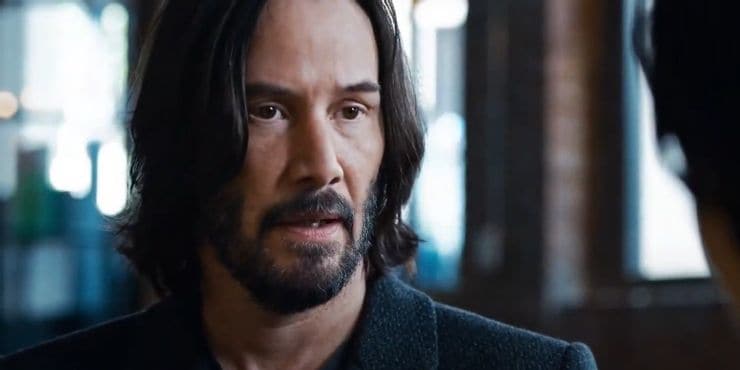The Matrix was my first R-rated movie. For many millennials, myself included, the cyberpunk epic looms large. It’s been almost two decades since the last installment of the series: Reloaded and Revolutions were released in 2003. The Matrix Resurrections, released December 22, 2021, feels like a generational retrospective: Keanu Reeves and Carrie-Ann Moss reprise their roles as Neo and Trinity, albeit with some of the wear and tear of middle age, and the movie is saturated with references and even flashbacks to its predecessors. Twenty years later, what does breaking free from virtual reality mean to us? Is it still any fun to watch?
Resurrections puts us 60 years after the events of Revolutions, its prequel. Neo is once again Thomas Anderson, having dropped the nom-de-guerre and returned to an ordinary life as a video-game designer. Trinity is now Tiffany, a married mom who catches Anderson’s eye at the local coffee shop. The movie makes clear that both characters have aged less than the time elapsed would suggest. This plot point builds intrigue but also helps us feel more comfortable with action heroes who by now are–like many viewers who remember the first movie–over the hill. None of us is as young as we were when the first Matrix came out, but if Reeves and Moss are any indication, we’ve still got it.
Yahya Abdul-Mateen II is a highlight in his role as a new version of Morpheus. Neo’s old handler has to make an intervention similar to the one he made in the first movie, offering Mr. Anderson the now-famous choice between blue pill and red bill, between keeping his mind closed to the Matrix and opening it again. But 2021 is not 1999: Abdul-Mateen has doffed Laurence Fishburne’s black leather for mustard dinner jackets and paisley cravats. A change in costume may reflect broader cultural shifts with respect to gender over the last twenty years. Tough now comes in haute couture.
Even more evident than the shift in gender is the shift with respect to psychedelics. Morpheus welcomes Neo to a safehouse lit up by projected images of the first movie. Morpheus wants the conditions to be just right so that when Neo takes the red pill, he will remember his old, rebellious ways. “Set and setting,” Morpheus says–a phrase usually used to refer to a psychedelic experience, meaning one’s mindset (shortened to “set”) and the physical and social environment (the “setting”) in which the user has the experience. In 2018, Michael Pollan, of Omnivore’s Dilemma fame, switched from gauging the socio-cultural impact of food to gauging the socio-cultural impact of psychedelics with his bestselling How to Change Your Mind: What the New Science of Psychedelics Teaches Us About Consciousness, Dying, Addiction, Depression, and Transcendence. Morpheus the prophet is now Morpheus the trip guide.
Jada Pinkett Smith plays a somewhat awkwardly-aged version of her character Niobe–the 60 years have apparently not been so kind to her. As leader of the free human city of Io, Niobe gives voice to the better part of age: Why bring Neo back for another fight, when peace is really what we need? Despite gray-haired protestations, Resurrections is as much a part of the “heroic bloodshed” genre as its prequels. In a world where people’s bodies can be taken over at any moment by an evil computer program, human life is infinitely disposable. But mowing bad guys down with assault weapons is less fun to watch now than it was as a teenager. The last two decades have cast not just masculinity or psychedelics in a different light, but also gun violence: the first Matrix was released just a month before the Columbine shooting.
Shoot-em-up notwithstanding, Matrix Resurrections is a love story. The whole plot turns around Neo’s desire to get back together with Trinity, which requires first that he wake her up from her Matrix-fed delusion that she is nothing more than an ordinary middle-class mom. The original Matrix was a love story, too, but it was also a movie about the collective struggle for human freedom. Resurrections ties love story and collective struggle together by putting Neo and Trinity’s relationship quite literally at the center of the Matrix–their love, kept unconsummated by malevolent AI, powers the whole system. The collective struggle part ends up becoming somewhat of an afterthought, especially since middle-aged Neo is depicted as having largely lost his will to fight, beyond the desire to be with Trinity again. The movie downplays the collective struggle as a concession to the fact that the characters have aged. They’ve been through this routine enough times to know that, however successful, their efforts will only be met by an ever more subtle and nefarious version of the Matrix. Neo is too old for ideological grandstanding, but he knows who he loves. The rest of humanity can at least be grateful that our salvation rests on his getting the girl.
In Resurrections, as perhaps in life, time has worn away some of the Matrix’s mythological luster. Disillusionment and uncertainty do relax our grip on the big ideas that make life feel like an epic struggle between good and evil. But is it an adequate response to disillusionment with big ideas–or an adequate motivation for a Matrix movie, with its theme of the struggle for freedom–to narrow our horizons back to finding the old spark of romantic love? All of us have gotten older since black-leather Morpheus showed up and gave Neo a terribly earnest choice between good and evil. But if Neo can’t bring himself to care about the bigger picture anymore, then some part of us, however adolescent, may feel like the Matrix really has won.
-//-
The Matrix Resurrections is available in the theaters or at home on HBO Max.
Image courtesy of Warner Bros. Pictures


